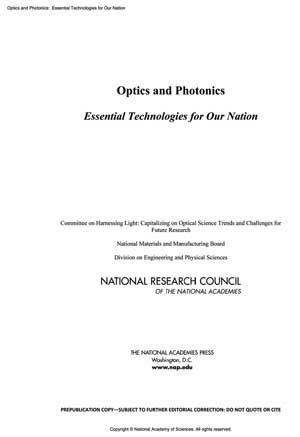Despite lingering economic concerns, the photonics community is looking ahead to a brighter future – even if it means more work in the short term.
Ask members of the photonics industry to describe the current state of the market, and the word “uncertainty” is likely to come up.
“Uncertainty as to the fiscal plan for the US has made many companies hesitant to make capital investments,” said Dr. Stephen D. Fantone, president and CEO of Optikos Corp. “This uncertainty slows down the decision-making process and causes organizations to reduce the velocity of the business activities.”

Lasers and other photonic technologies, such as machine vision, have taken over manufacturing and promise to stay strong well into the future.
Mike Cumbo of Idex Corp. agreed. “Uncertainty about the impact of the US fiscal cliff and Obamacare-related taxes on medical devices are causing investment delays across the economy, including the photonics industry.”
“Everyone is going to tell you that the main factor is the uncertainty,” said Ken Kaufmann, vice president of marketing at Hamamatsu. “People are not making decisions – it’s all over The Wall Street Journal: People are just putting off spending because the money they spend may not be spent wisely if things change.”
Industry leaders identify communications, medicine and manufacturing as particularly bright spots for photonics today.

Communications remains another promising area for photonics: Continued growth here
could help boost the economy.
“The ongoing adoption of photonics technology in industrial material processing and life science applications is driving the strongest growth vectors in the otherwise sluggish global economy,” Cumbo said.
Many industry leaders look to medicine and the life sciences as particularly promising for photonics. “Biophotonics is an interesting market for many reasons, both technologically and for its market diversification and market size potential,” said Carlos Lee, director general of the European Photonics Industry Consortium (EPIC). “Biophotonics addresses our societal health challenges with solutions for point-of-care devices and disposables. Biophotonics provides imaging and sensing for in vitro and in vivo applications, for patient monitoring, diagnostics and therapy.”
The biggest impact photonics can have on the economy in the next few years is likely to come from medical applications, Cumbo said. “Anything that helps to reduce the cost of delivering high-quality health care, whether in diagnostics or therapeutics, will enjoy strong demand and will have a big impact on the economy.”
Green photonics came up on both the brighter and the darker side.
“The government’s investment in the solar, wind and automotive industries, along with the US energy policy, has provided a positive effect on the photonics industry,” said Bill Shiner, vice president of industrial lasers at IPG Photonics Inc. Laser applications in those areas include cutting, welding, processing and more.

Industry experts are split on whether solar technologies are a smart investment today.
Some industry leaders say that solar will continue to enjoy growth; others say that reduced government support in Europe and elsewhere will cause photovoltaic (PV) technologies to weaken as an economic force.
“At the moment, I would stay out of PV manufacturing, especially thin-film,” said Lukas Krainer, CEO of Onefive GmbH and a member of EPIC. “The reduction of feed-in tariffs will further lead to a consolidation in the PV market and a reduction in global PV manufacturing capacity. This will continue to put [pressure] on laser vendors as well.” The availability of “secondhand” PV manufacturing equipment will keep opportunities in this sector on a relatively moderate level for the near future, he added.
Kaufmann predicted that photonic technologies for military applications, especially sensors, are likely to remain in demand, despite the current uncertainty – there’s that word again – about government spending.
“Certainly, fiber optics will be a growing area,” he said. “Right now, the design is done here, and the manufacturing has moved overseas. But as manufacturing costs go up in China, maybe some will come back.
“If we can get that and turn the education system around and demonstrate an educated workforce, that’ll help.”
“Manufacturing” may just be the brightest word. “Consumer has taken off as the driver,” Kaufmann said. “As we know, photonics is in so many consumer products. Look at head-up displays, which are coming to cars; people are talking about walking around in head-up displays or Google glasses.”
Fantone concurred, citing growing deployment of low-cost imaging devices in smartphone cameras and automotive cameras as an example; Lee named intelligent lighting systems as another area of grand potential. Eliezer Manor of Shirat Enterprises in Israel highlighted optical computing.
Materials processing and quality control are big segments where photonics plays a large role – and will continue to do so.
Replacing CO2 laser systems with fiber laser systems will make a big difference, said Shinji Niikura of Coherent Japan Inc. “For the next few years, fiber laser application to material processing, especially [in the] automobile industry, will make the biggest impact. Fiber lasers with moderate output power range (500 W to 3 kW) will dominate the material processing such as cutting and welding of small/thin materials.”
Large-volume manufacturing is a huge application of photonics, but the US may not yet be able to compete with Germany, Kaufmann said. “They’ve done a great job of developing photonic technology for manufacturing. We’re nowhere near where they are.”
Several sources for this article pointed out that European governments seemed to pay more attention to the first Harnessing Light report than the US government did.
“I’m not advocating industrial policy, but doing the development and investing in the basic research,” Kaufmann said. “The government is not able to pick the winners and losers.”
Solyndra is one example; in that case, the government decision makers were looking at the wrong factors, Kaufmann said. “The government is not set up to do that – they have too many people putting pressure on them that have nothing to do with what’s really the best decision.”
Krainer of Onefive pointed out that industrial lasers will “continue to gain traction in many applications where, in the past, traditional approaches – mechanically based – were widely used; for example, in the medical field, life science, display/lighting or automotive. The impact of macroecononomic events will not directly influence revenues in these application areas, as laser-based solutions offer a clear and huge added value for the end customer; therefore, spending will stay on a high level. In the scientific domain, it could well be that a potential reduction in government funding and programs, at least in the Western world, will impact sales into that area.”
Harnessing Light
Many argue that the government has a huge part to play in supporting photonics as a science and also as an industry. In the US, for example, photonics as a technology has not always enjoyed the same attention as electronics, perhaps in part because of the extreme vastness of applications that photonics covers. But with some effort, that could change – with big effects on the economy.
The US National Research Council (NRC) conducted an optics and photonics study in 1988 called Photonics: Maintaining Competitiveness in the Information Era. Ten years later, the NRC revisited the topic with a follow-up titled Harnessing Light: Optical Science and Engineering for the 21st Century. Both reports detailed areas of opportunity in photonics and optics.

The National Research Council report Optics and Photonics: Essential Technologies for Our Nation outlines a plan of action to help photonics realize its full potential.
The NRC’s latest study, Optics and Photonics: Essential Technologies for Our Nation, released in August, reviews advances and opportunities that have come up in the intervening 14 years, including market and workforce trends, and also looks ahead, making recommendations as to how the US can use photonics and related technologies to strengthen its economy.
Photonics and optics as key enablers represent a growing trend in the global economy, the report points out, and it is up to the US – government, industry and academia alike – to ride the wave. They call for improvements in how the US manages public and private R&D resources, and they encourage a portfolio approach to investing in the diverse opportunities currently available in the photonics industry.
The report was designed to rally the photonics community and, further, to give this community the tools it needs to promote itself to other industries and government.
“In a time of economic uncertainty, you need to educate the people who are decision makers in industry and in government. You need to have data to bolster your compelling arguments to keep existing programs and initiate new activities,” said Dr. Alan Willner, engineering professor at the University of Southern California in Los Angeles and co-chairman of the newest report.
The report focuses on key industries in which photonics is an enabling technology: communications, defense, energy, health, manufacturing, instrumentation, materials and displays. Growth in these sectors, the new report says, will open up secondary markets that could have a major impact on the US economy. “This makes the next decade potentially a very exciting time for optics and photonics, with significant opportunities for US leadership in these areas,” committee representatives wrote in a brochure accompanying the study.
Furthermore, only national R&D investment into technologies such as high-volume, low-cost photonic circuits will enable the ubiquitous deployment of photonics for communications, information processing, biomedical, defense, sensing and security challenges.
“We have to make sure we can compellingly justify the existing resources that are devoted to R&D in our industry,” Willner said. “That’s one of the challenges: to compellingly justify to decision makers in industry and government.”
Part of that justification will involve quantification and, further, education about the many fields affected.
“How do you create a budget for your house if you don’t know how many people live in your house, how much you spend on food and so on?” Willner said. “The government doesn’t know how many people work in optics and photonics, and they don’t keep track of government R&D funding in our field. Moreover, many companies that don’t consider themselves ‘optics and photonics’ actually rely heavily on optics and photonics. But the industry doesn’t effectively keep track of photonics-specific data.”
Sometimes it’s clear that the people in charge are not entirely sure just what photonics is and what it does. “There seems to be a lack of general understanding in some economic circles of how totally optics and photonics underpins so much in our society,” said Erik Svedberg, senior program officer of the National Materials and Manufacturing Board at the National Academies; Svedberg was the study director for the latest Harnessing Light report.
Willner said that, when they were trying to round up participants for the latest NRC study, he called someone at a federal agency but was initially turned down because the person didn’t consider the projects he funded to be photonics-related.
“Of course, you don’t take no for an answer,” Willner said. “So I kept talking to him about optics and photonics, and after about 10 minutes he said, ‘Well, I guess I do fund about $100 million in projects where optics and photonics play a key innovative role in those contracts.’ Communicating the idea that we enable so many things is crucial.”
And the many things photonics enables vary widely. For communications, the NRC report recommends that the US government and industry focus on communication devices and network capacity. In the manufacturing sector, recommendations include development of additive manufacturing or 3-D printing technologies; defense- and national security-related goals include better detection, surveillance, communications and weaponry. For health care, the report recommends that our industry partner with clinicians and the biotech industry to create new biosensing equipment as well as better approaches to testing of pharmaceuticals.
Energy production and energy efficiency are two major areas of focus for the NRC report, and the authors suggest a plan by the US Department of Energy (DoE) to employ optics to achieve grid parity nationwide by 2020; also, better sensing technologies could help improve other means of energy production, such as oil and gas. And they add that solid state is the wave of the future in lighting, recommending that the DoE aid development of more-efficient LEDs.
Finally, advances in single-photon detection – specifically, improvements in the generation of unique photonic beams with prearranged photonic structures – will mean big things for products in the decades to come, and the authors encourage US funding agencies to invest in R&D in this area.
All of this, the report’s authors and supporters argue, will help bolster the US economy (and the global economy as well), especially if careful attention is paid to R&D investment in the form of public-private cooperation.
And this attention should take the form of a national photonics initiative aimed at bringing together policy makers, industry managers and government agencies as well as academic and industrial researchers to coordinate photonics R&D spending and related investments.
“The issue going forward – the key recommendation – is having a broadly defined national initiative,” Willner said. “To have coordination, so that government, industry and academia can get together into market-specific consortia, such as communications, health and medicine, manufacturing, defense, energy and more.”
“Initiative” might not even be the right word, Willner added. “ ‘National photonics initiative’ might imply that the government will come in and hand down dollars. This is more about, as a nation, coming together – because we enable so much in society.”
One more important recommendation in the new report is the establishment of a national foundry to enable rapid prototyping of new photonic technologies. “Now is the time,” Willner said. “Because, frankly, there are places around the world that have done it.”
He cited Mosis, the foundry that helped grow the semiconductor industry in the US, as a model. “Essentially, it was a national resource where people in small companies and students in academia could design an electronic integrated circuit, and it would be fabricated by Mosis, and they would get it back for prototyping and testing,” he said. “We don’t have such a thing – unless you’re in one of the few labs that are very well equipped, you can’t get fabricated the photonic circuits that you are designing.”
And that can have big effects on the industry. As an anecdotal example, Willner described one of his students a few years back, who had designed novel optical waveguides. “He published a few papers, and I tried furiously to call people I know – friends, companies, other academics – to get it made. I couldn’t do it. I spent a couple years trying to get it done.
“Next thing I knew, there was a paper from Singapore, referencing ours – they’d fabricated my student’s waveguides. They referenced us, which was nice, but they made it when we couldn’t. The same thing happened the next year with a different paper from my student and a different university in Hong Kong. Again, they referenced us, but … ”
Pulling together the many industries enabled by photonics will advance not only the technology, but also the economy, the report urges. “The hope is that there’s a change now,” Willner said, “for two reasons: One, given that optics and photonics does enable so much, now’s the time to take hold of it and make sure the future is even brighter. And two, if we don’t do it, somebody else will. The US leadership role is far from secure.”
Education issues
But to support any real change in the future, we need to build a sturdy foundation. Right now, the US government is not investing in the long term, Kaufmann said. “Everything needs to have a short-term economic benefit. R&D is becoming [only] development, not research.”
Focusing on product development but not basic research will lead to more difficulties later on, Kaufmann said. “We have been eating our seed corn, so I think that is a really huge problem.”
A lot of it comes back to education. “Our education system is in terrible shape,” Kaufmann said. “A large number of good-paying jobs are going by the way because they can’t fill them.” There are not enough trained people for all of the existing opportunities.
“Major universities on the state level are under real stress because of budget problems. Ultimately, people will go somewhere else: Singapore, China. Some of the very best will go to Singapore.” He mentioned that MIT and other schools now have campuses in Singapore to capitalize on this trend.
“And then there’s the problem that, in our education system, a large number of our technology grads are not native-born Americans, so now with the immigration policy – a nation of immigrants has a fear of immigrants, which I think is really ironic – so a lot of the talented people are going back. We’re basically paying for the training of our future competitors,” he said.
Universities are becoming less of a training ground, more about being profit centers, Kaufmann said. “They’re recruiting people from other countries because they’ll have to pay the full cost – no scholarships – and then they leave. This has a direct effect on photonics.”
Many students are going into finance instead of technology, Kaufmann said. “They see people getting compensated more in finance than technology, so they choose to go there. That’s changing now, but we’ve already lost a generation of people.
“The biggest problem is that we’re investing too short-term. The government shouldn’t be in the business of funding things that will lead to products. They should be spending the money on basic research and educating people. People are getting priced out of a college education. They end up with $70,000 or $80,000 of debt and no way to pay it off.”
Funding can be a problem from the community college level up to graduate programs. “The drop in state funding continues to hurt us because tuition pays only a small part of the cost of educating a student,” said Judy Donnelly, Laser and Fiber Optic Technology program coordinator at Three Rivers Community College in Norwich, Conn. “This is particularly difficult in the technologies where classes are small, labs are expensive to outfit and operate, and it’s difficult to find qualified faculty – largely because of the low starting salaries.”
Silver lining
But the overall message in the photonics economy is one of hope, not despair, and the best way to realize a positive outcome, industry leaders say, is to think big and invest wisely in research and development.
“Companies need to prepare to delocalize if a region is not competitive, and prepare for global competition,” said Lee of EPIC. “One may feel comfortable in a small market, but when the growth is in sight, it will start to attract attention from other regions. … Some fields in photonics are still niche, but they need to prepare for fierce competition.”
The growth potential inherent in photonics is clear – now it’s up to the photonics community to bring it about. “The bright part is that there is so much more optics and photonics can do in the future that we have not yet seen,” Svedberg said. “Just look at the use of lasers today, and think about the fact that it initially was a ‘solution looking for a problem.’ ”